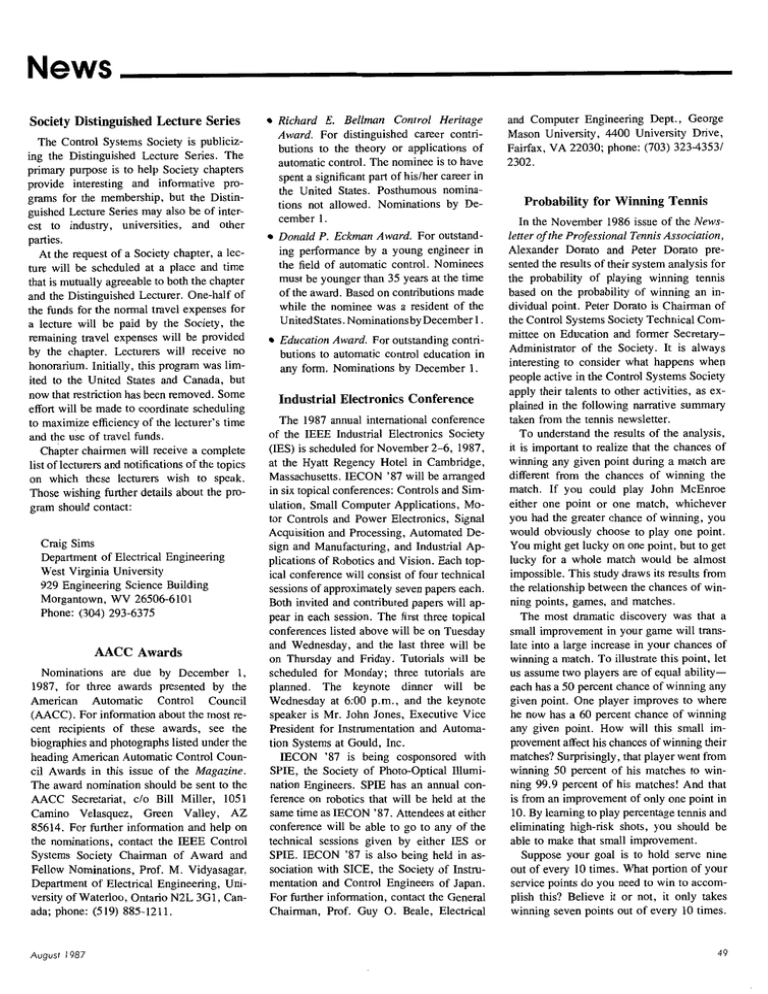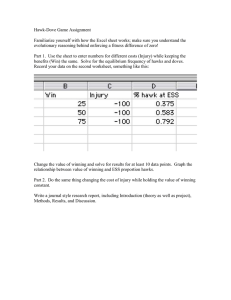Society Distinguished Lecture Series AACC Awards Industrial
advertisement

News Society Distinguished Lecture Series The Control Systems Society is publicizing the Distinguished Lecture Series. The primary purpose is to help Society chapters provide interesting and informative programs for the membership, but the Distinguished Lecture Series may also be of interest to industry, universities, and other parties. At the request of a Society chapter, a lecture will be scheduled at a place and time that is mutually agreeable to both the chapter and the Distinguished Lecturer. One-half of the funds for the normal travel expenses for a lecture will be paid by theSociety,the remaining travel expenses will be provided by the chapter. Lecturers will receive no honorarium. Initially, this program was limited to the United States andCanada, but now that restriction has been removed. Some effort will be made to coordinate scheduling to maximize efficiency of the lecturer's time and the use of travel funds. Chapter chairmen will receive a complete list of lecturers and notifications of the topics on which these lecturers wish to speak. Those wishing further details about the program should contact: Craig Sims Department of Electrical Engineering West Virginia University 929 Engineering Science Building Morgantown, WV 26506-6101 Phone: (304) 293-6375 AACC Awards Nominations aredue by December 1, 1987,for three awards presented by the American Automatic Control Council (AACC). For information about the most recent recipients of theseawards, see the biographies and photographs listed under the heading American Automatic Control Council Awards in this issue of the Magazine. The award nomination should be sent to the AACC Secretariat, c/o Bill Miller, 1051 Camino Velasquez, Green Valley, AZ 85614. For further information and help on the nominations, contact the IEEE Control Systems Society Chairman of Award and Fellow Nominations, Prof. M. Vidyasagar, Department of Electrical Engineering, University of Waterloo, Ontario N2L3G1: Canada; phone: (519) 885-121 1. August I987 Richard E. BellmanControl Heritage Award. For distinguished career contributions to the theory or applications of automatic control. The nominee is to have spent a significant part of histher career in the United States. Posthumous nominations not allowed. Nominations by December l . D O F ~ P. M Eckman Award. For outstanding performance by a young engineer in the field of automatic control. Nominees must be younger than 35 years at the time of the award. Based on contributions made while the nominee was a resident of the Unitedstates. Nominationsby December 1. Education Award. For outstanding contributions to automatic control education in any form. Nominations by December 1. Industrial Electronics Conference The 1987 annual international conference of the IEEE Industrial Electronics Society (IES) is scheduled for November 2-6, 1987, at the Hyatt Regency Hotel in Cambridge, Massachusetts. IECON '87 will be arranged in six topical conferences: Controls and Simulation, Small Computer Applications, Motor Controls and Power Electronics, Signal Acquisition and Processing, Automated Design and Manufacturing, and Industrial Applications of Robotics and Vision. Each topical conference will consist of four technical sessions of approximately seven papers each. Both invited and contributed papers will appear in each session. The first three topical conferences listed above will be on Tuesday and Wednesday, and the last three will be on Thursday and Friday. Tutorials will be scheduled forMonday;three tutorials are planned. The keynote dinner will be Wednesday at 6:OO p.m., and the keynote speaker is Mr. John Jones, Executive Vice President for Instrumentation and Automation Systems at Gould, Inc. IECON '87 is being cosponsored with SPIE, the Society of Photo-Optical Illumination Engineers. S P E has an annual conference on robotics that will be held at the same time as IECON '87. Attendees at either conference will be able to go to any of the technical sessions given by either IES or SPIE. IECON '87 is also being held in association with SICE, the Society of Instrumentation and Control Engineers of Japan. For further information, contact the General Chairman, Prof. Guy 0. Beale, Electrical and Computer Engineering Dept., George Mason University, 4400 University Drive, Fairfax, VA 22030; phone: (703) 32343531 2302. Probability for Winning Tennis In the November 1986 issue of the Newsletter of the Professional TennisAssociation, Alexander Dorato and PeterDorato presented the results of their system analysis for the probability of playing winning tennis based on the probability of winning an individual point. Peter Dorato is Chairman of the Control Systems Society Technical Committee on Education and former SecretaryAdministrator of the Society. It is always interesting to consider what happens when people active in the Control Systems Society apply their talents to other activities, as explained in the following narrative summary taken from the tennis newsletter. To understand the results of the analysis, it is important to realize that the chances of winning any given point during a match are different from the chances of winning the match. Ifyou could play John McEnroe eitherone point or onematch, whichever you had the greater chance of winning, you would obviously choose to play one point. You might get lucky on one point, but to get lucky for a whole match would be almost impossible. This study draws its results from the relationship between the chances of winning points, games, and matches. The most dramatic discovery was that a small improvement in your game will translate into a large increase in your chances of winning a match. To illustrate this point, let us assume two players are of equal abilityeach has a 50 percent chance of winning any given point. One player improves to where he now has a 60 percent chance of winning any given point. How will this small improvement affect his chances of winning their matches? Surprisingly, that player went from winning 50 percent of his matches to winning 99.9 percent of his matches! And that is from an improvement of only one point in 10. By learning to play percentage tennis and eliminating high-risk shots, you should be able to make that small improvement. Suppose your goal is to hold serve nine out of every 10 times. What portion of your ' to accomservice points do you need to v.'In plish this? Believe it or not, it only takes winning seven points out of every 10 times. 49 The mathematical probabilities derived from the tennis scoring system demonstrate that the cumulative effect of a slight edge creates a large edge in the long run. That is why the slightly better of two players will almost always win in a match. The mathematics required in obtaining the probabilities presented here is based on the theory of finite Markov chains. It is a rather complicated theory, and its application to tennis first appeared in a text by John C. Kemeny and J. Laurie Snell, Finite Markov Chains. Fortunately, it is not necessary to understand the mathematics in order to benefit from its results. We give a table that can be used to determine winning probabilities. Simply read down a column to find the game, set, and match probabilities given a certain point probability. Winning-Probability Table Point Game Set 2-out-of-3 Set Match 3-out-of-5 Set Match 0.520 0.550 0.640 0.705 0.540 0.599 0.763 0.859 0.560 0.647 0.859 0.946 0.600 0.736 0.963 0.996 0.750 0.910 0.978 1.00 Alex Dorato is currently the Associate Tennis Coach at Yale University. He played varsity tennis 1978-1982 at the University of New Mexico. He is also head tennis pro at the Pine Orchard Yacht and Country Club in Branford, Connecticut. and has been a USPTA member since 1983. Dr. Peter Dorato is a Professor of Electrical and Computer Engineering at the University of New Mexico. Although a late starter-he played his first USTA tournament at 35-he is an avid player and has been consistently ranked in the senior divisions of the Southwest. He is an expert in engineering systems analysis, and this article, written with his son Alex, is an application of this type of analysis to the scoring system in tennis. Social Implications of Technologv Among IEEE societies, the IEEE Society on Social Implications of Technology (SSIT) is unusual in that its scope encompasses d l areas covered by the IEEE. Every IEEE member should consider joining. Perhaps the best way to indicate what SSIT is all about is to mention some of the issues that it has 50 been involved in. One category has to do with the societal impact of specific technologies: the effects of automation on the lives ofoffice workers, how computers can be adapted for use by handicapped people, the use of electronic devices to help relieve the energy problem by facilitating time-varying pricing. the controversy over nuclear power. The public policy issues are considered that span broad areas of engineering: risk assessment, star wars, environmental effects, government-imposed secrecy in engineering and science. Another important general area is that of engineering ethics-the professional obligations of engineers-and how this is affected by the conditions under which they work. Here we consider not only the effects on society as a whole but effects on en,‘Olneers themselves. Of particular interest are proposals for making it easier for employee engineers to operate as responsible professionals. SSIT presents its Award for Outstanding Service in the Public Interest to engineers who uphold ethical principles despite risks to their careers. SSIT provides a forum for the discussion of these and other subjects in the pages of its highly rated quarterly magazine, Technofogy and Socieg, and via sessions that it organizes at various conferences and at its annual meeting. Since many of the topics it treats are of a controversial nature, differing views are often presented. IEEE members can join SSIT for the annual dues rate of $12.00; the student rate is half that for regular members. Simply mail your check, payable to IEEE. along with your IEEE member number, name, and address to: IEEE Service Center. 445 Hoes Lane,P.O. Box 1331, Piscataway, NJ 08855-1331. ASME Energy Resources Awards TheCool Water Coal Gasification Program in Daggett, California, and four other projects won Energy Resources Technology Awards in a new contest sponsored by ASME’s Energy Resources Technical Group. First announced last year, individuals and companies developing, applying, or using designs, methods, techniques, or processes involving mechanical engineering in energy resources technology were invited to enter the contest. The technology used by an entry had to be less than five years old. and entries must contribute to the industrialization of the energy resources industry and to the improvement of the U.S. position in the wodd market for a product or service. The first-place winner was the Cool Water Coal Gasification Program in Daggett, California. The 100-MW, integrated, gasification, combined-cycle electric power plant has been in commercial operation since June 1984 and was cited for firmly establishing domestic coal as a source of clean, economical, and efficient energy for electric utilities in the United States. In the program, coal is used in a continuous process to produce steam for steam turbines and syngas for gas turbines, and both produce electricity. The coal is ground and mixedwith water to form a slurry that is burned to produce syngas and heat. The heat produces steam for the turbines and, after cleaning, the syngas is burned to operate the gas turbines. The four other winning entries were the Advanced Toroidal Facility at Oak Ridge National Laboratory; the Biomass Gasification System at Southern Electric International; the Cascading-Bed Process for Retorting Oil Shale at Lawrence Livermore National Laboratory; and the Zinc Ferrite Hot Gas Desulfurization Process at Mogantown Energy Technology Center. The Advanced Toroidal Facility at Oak Ridge National Laboratory is a project of Martin Marietta Energy System, Inc.’s, fusion energy division. Scheduled to begin operation thisyear. the facility will bethe world’s largest stellarator experiment and will be used to explore eventual commercial applications of fusion power. The Biomass Gasification System, located in Quincy, Florida. is a project of Southern Electric International. The plant converts wood chips or wood waste to gaseous fuel. The fuel is used by a major clay processing and mining company. Located in Livermore, California, and a project of the Lawrence Livermore National Laboratory, the Cascading-Bed Process for Retorting Oil Shale was cited for efficiently separating oil from crushed oil shale in an above-ground processing plant. This new process uses the residual carbon char left in the shale after separation to provide energy for the system. Once the process is begun, no additional fuel is required to provide energy for the separation process. The Zinc Ferrite Hot Gas Desulfurization Process is a program developed at the Department of Energy’s Mogantown Energy Technology Center in Morgantown, West Virginia, to desulfurize hot coalderived gas. The process is regenerable and replaces wet scrubbing currently used to control sulfur in coal-based electric-generating facilities. I€€€ Control Systems Mogozine



